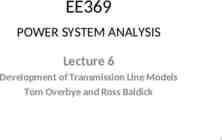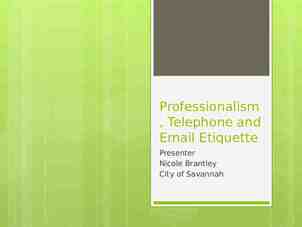Better listeners versus more listening: rethinking the
34 Slides462.50 KB
Better listeners versus more listening: rethinking the Comprehension Approach John Field Universities of Reading and Cambridge, UK
The Comprehension Approach Pre-listening: motivation, mental set Extensive listening: general questions Pre-set task or questions Intensive listening Checking answers (? with replay?) [Language review] [Listen with tapescript]
Teaching not testing ‘Until we have some diagnostic procedures, the teacher [of L2 listening] can only continue to test comprehension, not to teach it. We need to move into a position where the teacher is able to recognise particular patterns of behaviour in listening manifested by an unsuccessful listener and to provide exercises for the student which will promote superior patterns of behaviour (superior strategies)’. (Brown, 1986: 286)
Concerns about the Comprehension Approach Teacher-centred; isolation of learners The notion of ‘right’ and ‘wrong’ answers Origins in L2 reading methods; consequent misconceptions about the nature of listening Heavy emphasis on meaning building at the expense of decoding Emphasis on the products of listening in the form of correct answers, and not the process
A partial solution: a diagnostic approach a. Teacher adopts a non-interventionist stance Who thinks the answer is A? Who thinks it is B? Shall we hear it again? b. Teacher follows up both right and wrong answers. Why do you think answer A is right? Why do you think answer B is right?
A more radical solution (Field 1998) An approach based upon intensive small-scale exercises that practise the various sub-skills that contribute to skilled listening. A distinction between – sub-skills (part of the behaviour of a skilled listener) – strategies used to compensate short-term for problems of understanding.
Field (2008):A process approach Listening is a form of expertise. We acquire it like other skills such as playing chess or driving. Achieving any type of expertise requires the novice to adjust slowly to the way in which an expert behaves Teachers need to understand expert behaviour if they are to induce it in novices. Becoming an expert of any kind requires: – Intensive practice in important processes so that they become more and more automatic – Combining the processes into larger operations – Exposure to real-life experiences, where taught processes have to be used appropriately and under the pressure of time.
A process approach assumes: Language instruction is not the solution: knowledge recognition
A process approach distinguishes Decoding: matching groups of sounds in the speech stream to words in the listener's vocabulary Meaning building: constructing a largerscale meaning on the basis of the words that have been decoded. Both are critical to successful listening
A process approach: 3 strands 1. Expose Teachers need greater understanding of the nature of the input, and its problems for learners; 2. Model Teachers need a methodology that trains better listeners instead of just providing practice; 3. Enable Learners must be helped to crack the code of speech at an early stage, despite their lack of a) language knowledge b) experience of L2 listening.
1. Expose: Understand the input (Brown, 1990) * Much variation in the signal * No consistent boundaries between words * No physical evidence: the listener needs to carry meaning forward in the mind. * Time pressures – On-line processing – Timing is largely controlled by speaker
Variability of speech Phoneme variation Word variation assimilation – elision pressures inside the intonation group Speaker variation voice – speech rate – context – accent
Implications for teaching Examples of the same words / phrases in different voices and contexts Repetition and recycling. The importance of replay. Attention to chunks and to rhythm (esp. as a means of decoding function words)
Focused practice in L2 input Identify aspects of the input that are likely to cause problems of decoding Practise each one intensively by means of small-scale micro-listening exercises Use simple exercise types such as transcribing short sentences
Weak form decoding exercise Write down what you hear. [samples of authentic or naturalistic speech] – – – – I should have [ə] done. Just wait a [ə] moment. A box of [ə] cigars. The buses are [ə] late. – – – – I’m I’m I’m I’m looking for a [frə] photo. looking at a [ətə] key. talking to [tə] the meeting. talking at [ət] the meeting.
2. Model: Emulate expert processing L1 processes provide a model for the L2 instructor L1 processes provide a benchmark that enables us to understand better where L2 problems lie. Rationale: long exposure has enabled L1 listeners to adopt routines which are more effective and more highly automatic than those of L2 listeners.
Questions about L1 processes How do expert listeners process syllables? L1: [ˡspɔ:t] L2: [eˡspɔ:t] [sɪˡpɔ:t] How do expert listeners recognise words by association with words heard earlier? DOCTOR – nurse How do expert listeners deal with unfamiliar words? How do expert listeners make use of intonation patterns and pauses in the input? How do expert listeners recognise words in connected speech?
An approximate process Listening, even in L1, is an approximate process The listener decodes the input, about a syllable behind the speaker But listeners often cannot identify words accurately until several syllables afterwards. So, at both word and syntax level, a listener has to construct a provisional message which may have to be revised.
ð ə k æ p t ɪ n z ɪ ŋ k æ b ɪ n s ɪ k s t i: n
The expert listener versus the novice [maɪˈtreɪn] my train / might rain / (might train) or might rain might train my train snow might rain or snow [maɪˈtreɪn] my train or my train or snow my train or snow
How do expert listeners recognise grammar patterns? The heavy fall clumsily The actor learnt the words had been written by Shakespeare The teachers taught by modern methods did better than their colleagues The rescuers discovered the plane had crashed The promise made was finally kept.
Exercise types (Field: Listening in Language Classroom, Chap 12) a. Teacher plays a sentence from a recording of natural speech. Learners transcribe the words they understand. Teacher replays, learners add more words. Learners compare answers, teacher replays. b. ‘Listen and fill in the missing words’. Teacher gives learners a transcript, in which groups of words (not just single words) have been omitted. c. ‘Write what you hear’. Teacher dictates ambiguous sequences to the learners, adds an unexpected ending. a nice cream dress the way to cut it is like this some boxes have arrived I want to drive a train.
Dealing with unknown words I found out that the thud was the cat I found I I I I fog found found found found I found the sound was the cat out that the front was the cat the thing was the cat the of the cat that the sun in the cat out the frog and the cat out that is a cat that was the cat I thought it was a cat in the front was the cat out where was the cat what I thought that a cat
Unfamiliar words I found out that the thud was the cat. L2 listener in class – ‘Can you work out the meaning from the context?’ L2 listener in the real world – the thought / front / sun was the cat L1 listener hearing a new word: – Identify as new word rather than known – Ignore – Generalise – Infer meaning from context
New word or known? Exercise types (Field: Listening in the Language Classroom, Chap 12) a. ‘Which word doesn’t belong? Write it.’ Teacher dictates sets of words, where the ‘odd one out’ is an unfamiliar word that resembles a familiar one. summer – autumn – string – winter purple – yellow – drown - green – orange cousin – sister – nephew – ankle – daughter b.Teacher plays a short authentic passage. Learners identify new words (e.g. count how many, attempt to transcribe them).
3. Enable. Short term techniques We can design a long-term developmental programme based upon: Familiarising the listener with L2 input Training the listener in L1 processes. But meanwhile the learner needs strategies for making sense of what she hears despite limited language knowledge – a. to participate in L2 encounters – b. to benefit from real-world sources – c. to sustain motivation
Explicit teaching of listening strategies Raise awareness of strategy use. Present the strategies one by one. Practise the strategies individually. Learners evaluate their own strategy use.
Problems of explicit teaching Many standard check-lists of L2 strategies were constructed with speaking in mind. The strategy that is chosen depends heavily upon the problem of understanding that has occurred. Effective strategy use is appropriate rapid a choice between alternatives.
A task-based approach to strategies 2000) Intensive listening 1 (short section) – Ss write down words they understand – Ss form hypotheses linking the words – Ss compare notes in pairs Intensive listening 2 (replay) – Ss write down more words – Ss revise guesses, discuss in pairs – Ss present ideas to class. Teacher neutral Intensive listening 3 (replay) – Ss revise guesses; discuss in pairs – Class evaluates. T assists Final play. (Field
A role for the comprehension approach Training in listening, like training in any form of expertise, requires: – Intensive micro-listening exercises that focus on a particular process, combined with – Exposure of the kind the comprehension approach gives [But we need to rethink the way in which we implement the comprehension approach in the classroom]
Summary: A process approach to listening 1. diagnoses why understanding fails 2. identifies phonetic features of the TL which are likely to cause decoding problems for L2 listening; 3. recognises processes which characterise the performance of the L1 listener; Uses this information to build a programme of microlistening practice, with exercises that involve the transcription or interpretation of short pieces of input. Supports with larger-scale comprehension work to ensure that the skills that are acquired become integrated into overall competence.
A long-term process programme must also allow for strategy instruction Purpose: to equip the learner short-term to make minimal sense of the input Strategy instruction needs to be mainly task-based so that strategies can be used a. in combination with each other b. in ways that take account of: the demands of the problem - the listener’s goals - the listener’s own listening style
References Brown, G. Investigating listening comprehension in context. Applied Linguistics 7/3 Field, J. 1998. Skills and strategies: towards a new methodology for listening. ELT Journal 52/2 Field, J. 2000. ‘Not waving but drowning’ ELT Journal 54/2 Field, J. 2008. Listening in the Language Classroom. Cambridge: Cambridge University Press
j.c.field@ reading.ac.uk Dr John Field, Dept of Applied Linguistics, University of Reading, Whiteknights, Reading RG6 6AA, UK







































